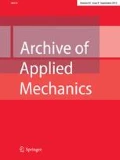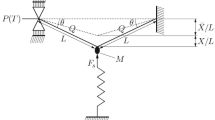Abstract
Buckling of a column under pre-load restraint has been found to differ from the conventional bifurcation problems and thus requires better understanding. To this end, a simple model consisting of two collinear rigid bars connected by a rotational spring, resting on a smooth surface, loaded by an axial force and restrained by a constant force at the common joint is investigated. The energy method is adopted to establish the equilibrium and stability conditions. The post-buckling response of the simple system indicates that the load-restrained buckling problem is a snap-through problem. The minimum possible buckling force and the buckling force based on the Maxwell construction are found to increase with the restraining force, and can be approximated by power-law functions. It is further shown that an energy barrier exists for the snap-through to occur and the buckling force depends on the perturbation energy. Sensitivity of this system to initial geometric imperfections is also investigated, and an energy barrier is also found to exist for the buckling of systems with imperfection amplitudes smaller than a certain critical value. The characteristic imperfection amplitude depends on the restraining force and, interestingly, transforms the snap-through problem into an eigenvalue problem identical to the conventional one, i.e., the one without imperfection and restraining force.















Similar content being viewed by others
References
Timoshenko, S.P., Gere, J.M.: Theory of Elastic Stability. McGraw-Hill, New York (1961)
Brush, D.O., Almroth, B.O.: Buckling of Bars, Plates, and Shells. McGraw-Hill, New York (1975)
Ziegler, H.: Principles of Structural Stability. Blaisdell Pub Co, Waltham (1968)
Bažant, Z.P., Cedolin, L.: Stability of Structures: Elastic, Inelastic, Fracture, and Damage Theories. Oxford University Press, Oxford (1991)
Kerr, A.D.: A model study for vertical track buckling. Federal Railroad Administration, Office of Research, Development and Demonstrations (1971)
Mróz, Z., Plaut, R.H.: On the stability and post-critical behavior of elastic structures with dry friction. Int. J. Solids Struct. 29(10), 1241–1253 (1992)
Medina, L., Gilat, R., Krylov, S.: Symmetry breaking in an initially curved pre-stressed micro beam loaded by a distributed electrostatic force. Int. J. Solids Struct. 51(11), 2047–2061 (2014)
Lignos, X., Ioannidis, G., Kounadis, A.N.: Non-linear buckling of simple models with tilted cusp catastrophe. Int. J. Non. Linear. Mech. 38(8), 1163–1172 (2003)
Hosford, W.F., Caddell, R.M.: Metal Forming: Mechanics and Metallurgy. Cambridge University Press, New York (2007)
Johnson, W., Mellor, P.B.: Engineering Plasticity. Van Nostrand Reinhold Company, New York (1978)
Lange, K.: Handbook of Metal Forming. McGraw-Hill, New York (1985)
Chen, K., Korkolis, Y.P.: Industry 4.0 in stamping: a wrinkling indicator for reduced-order modeling of deep-drawing processes. Procedia Manufacturing, 51, 864-869.(2020)
Gao, G., Miska, S.Z.: Effects of boundary conditions and friction on static buckling of pipe in a horizontal well. SPE J. 14(04), 782–796 (2009)
Mitchell, R.F.: The effect of friction on initial buckling of tubing and flowlines. SPE Drill. Complet. 22(2), 112–118 (2007)
Ju, G.T., Kyriakides, S.: Thermal buckling of offshore pipelines. J. Offshore Mech. Arct. Eng. 110(4), 355–364 (1988)
Yun, H., Kyriakides, S.: Model for beam-mode buckling of buried pipelines. J. Eng. Mech. 111(2), 235–253 (1985)
Lazopoulos, K.A.: Column buckling under friction. Arch. Appl. Mech. 61(4), 215–221 (1991)
Su, T., Wicks, N., Pabon, J., Bertoldi, K.: Mechanism by which a frictionally confined rod loses stability under initial velocity and position perturbations. Int. J. Solids Struct. 50(14–15), 2468–2476 (2013)
Martinis, J.A.C., Raous, M.: Friction and Instabilities. Springer, Vienna (2002)
Nguyen, Q.S.: Instability and friction. Comptes Rendus Mécanique 331(1), 99–112 (2003)
Chateau, X., Nguyen, Q.: Buckling of elastic structures in unilateral contact. Eur J Mech A Solids 10(1), 71–89 (1991)
Allan, T.: One-way buckling of a compressed strip under lateral loading. J. Mech. Eng. Sci. 10(2), 175–181 (1968)
Kyriakides, S.: Propagating instabilities in structures. Adv. Appl. Mech. 30(3), 67–189 (1993)
Golubitsky, M., Schaeffer, D.: A theory for imperfect bifurcation via singularity theory. Commun. Pure Appl. Math. 32(1), 21–98 (1979)
Acknowledgements
This research was supported by NSF award CMMI-1727490. This support is acknowledged with thanks. The authors also acknowledge fruitful discussions with Alexander Breunig, Matt Esser, Prof. Peter Groche, Prof. Jinjin Ha and Prof. Brad Kinsey on the problem of wrinkling in deep-drawing of thin sheets.
Author information
Authors and Affiliations
Corresponding author
Ethics declarations
Conflict of interest
On behalf of all authors, the corresponding author states that there is no conflict of interest.
Additional information
Publisher's Note
Springer Nature remains neutral with regard to jurisdictional claims in published maps and institutional affiliations.
Rights and permissions
About this article
Cite this article
Chen, K., Korkolis, Y.P. A simplified model of elastic column buckling under constant lateral force restraint. Arch Appl Mech 91, 2817–2832 (2021). https://doi.org/10.1007/s00419-021-01933-1
Received:
Accepted:
Published:
Issue Date:
DOI: https://doi.org/10.1007/s00419-021-01933-1




